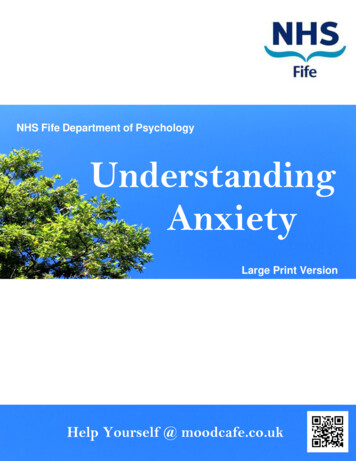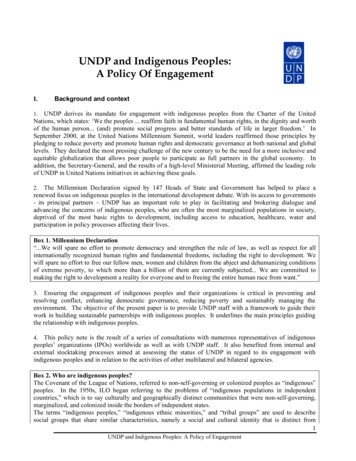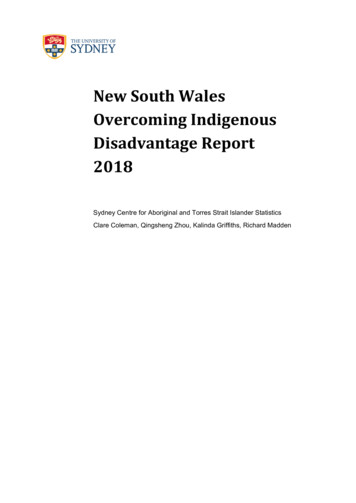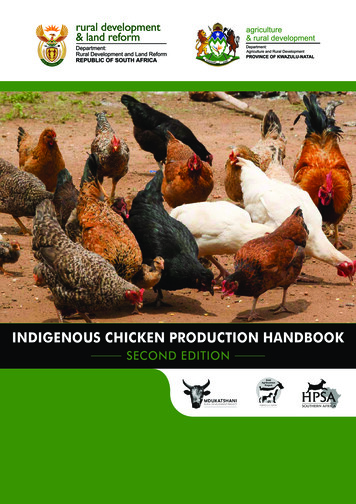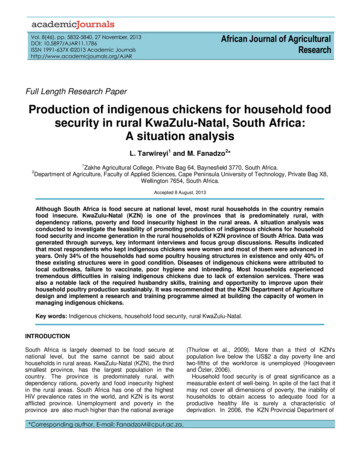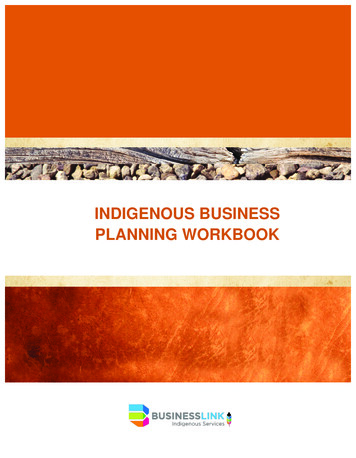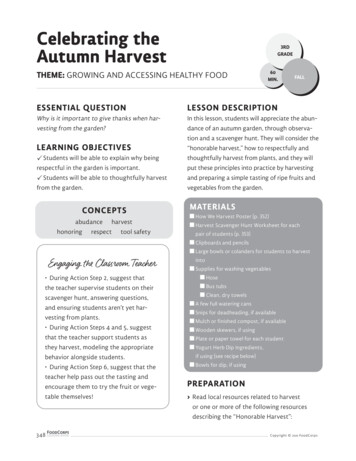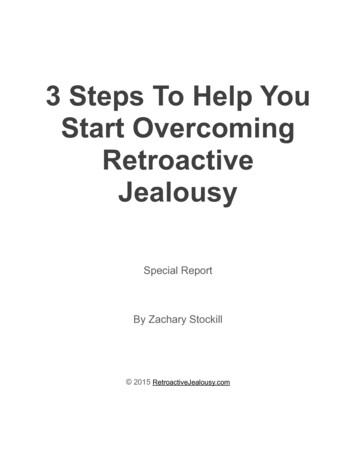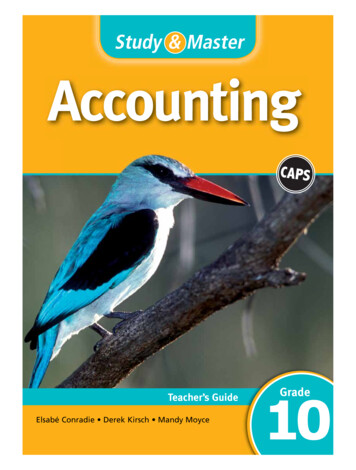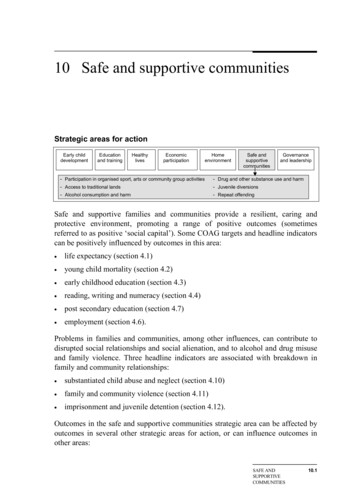
Transcription
10 Safe and supportive communitiesStrategic areas for actionEarly childdevelopmentEducationand onment- Participation in organised sport, arts or community group activities- Access to traditional lands- Alcohol consumption and harmSafe andsupportivecommunitiesGovernanceand leadership- Drug and other substance use and harm- Juvenile diversions- Repeat offendingSafe and supportive families and communities provide a resilient, caring andprotective environment, promoting a range of positive outcomes (sometimesreferred to as positive ‘social capital’). Some COAG targets and headline indicatorscan be positively influenced by outcomes in this area: life expectancy (section 4.1) young child mortality (section 4.2) early childhood education (section 4.3) reading, writing and numeracy (section 4.4) post secondary education (section 4.7) employment (section 4.6).Problems in families and communities, among other influences, can contribute todisrupted social relationships and social alienation, and to alcohol and drug misuseand family violence. Three headline indicators are associated with breakdown infamily and community relationships: substantiated child abuse and neglect (section 4.10) family and community violence (section 4.11) imprisonment and juvenile detention (section 4.12).Outcomes in the safe and supportive communities strategic area can be affected byoutcomes in several other strategic areas for action, or can influence outcomes inother areas:SAFE ANDSUPPORTIVECOMMUNITIES10.1
early child development (maternal health, teenage birth rate, early childhoodhospitalisations, basic skills for life and earning) (chapter 5) education and training (school attendance and attainment, Indigenous culturalstudies) (chapter 6) healthy lives (mental health, suicide and self-harm) (chapter 7) economic participation (labour market participation, Indigenous owned andcontrolled land and business, home ownership, income support) (chapter 8) home environment (overcrowding, access to water, sewerage and electricity)(chapter 10) governance and leadership (governance capacity and skills, engagement withservice delivery) (chapter 11).The indicators in this strategic area for action focus on the key factors thatcontribute to safe and supportive communities, as well as some measures of theimplications of a breakdown in family and community relationships: participation in organised sport, arts or community group activities —participation in sport can contribute to good physical and mental health,confidence and self-esteem, improved academic performance and reduced crime,smoking and illicit drug use. Indigenous people’s participation in artistic andcultural activities helps to reinforce and preserve living culture, and can alsoprovide a profitable source of employment (section 10.1) access to traditional lands — Indigenous people derive social, cultural andeconomic benefits from their connection to traditional country. Culturally,access to land and significant sites may allow Indigenous people to practise andmaintain their knowledge of ceremonies, rituals and history. Socially, land canbe used for recreational, health, welfare and educational purposes. The economicbenefits of land are discussed in more detail in section 8.2 of this Report. Thissection reports data on whether Indigenous people live on, or have access to theirhomelands/traditional country, but does not show whether Indigenous peoplehave control or ownership over their homelands, or access to particular sites thatmay be of special significance (section 10.2) alcohol consumption and harm — alcohol consumption has potential health andsocial consequences. Excessive alcohol consumption increases the risk of heart,stroke and vascular diseases, liver cirrhosis and several types of cancers. It alsocontributes indirectly to disability and death through accidents, violence, suicideand homicide. Alcohol misuse can also have effects at the family andcommunity levels, contributing to workplace-related problems, child abuse andneglect, financial problems (poverty), family breakdown, family violence, andcrime. This section examines patterns of alcohol consumption and alcohol10.2OVERCOMINGINDIGENOUSDISADVANTAGE 2009
related harms, including alcohol influenced crime and alcohol relatedhospitalisations and deaths (section 10.3) drug and other substance use and harm — drug and other substance misusecontributes to illness and disease, accident and injury, violence and crime, familyand social disruption, and workplace problems. Reducing drug related harm canimprove health, social and economic outcomes at both individual andcommunity levels. It is difficult to obtain accurate data on the use of illicit drugs,but this section reports available data on patterns of drug use, and drug relatedcrime, hospitalisations and deaths (section 10.4) juvenile diversions — Indigenous young people have a high rate of contact withthe juvenile justice system (see section 4.12). Juvenile diversion programs cancontribute to a reduction in antisocial behaviour and offending. There are nonational data on diversionary programs, but this section reports information ondiversion programs provided by some jurisdictions (section 10.5) repeat offending — Indigenous people are over-represented in prisons, and arelikely to come into contact with the criminal justice system at younger ages thannon-Indigenous people. Once Indigenous offenders come into contact with thecriminal justice system, they are more likely than non-Indigenous offenders tohave repeat contact with it. Therefore, it is important that Indigenous people whohave had contact with the criminal justice system have the opportunity tointegrate back into the community and lead positive and productive lives.Reducing reoffending may also help break the intergenerational offending cycle(whereby incarceration of one generation affects later generations through thebreakdown of family structures). This section reports both adult and (limited)juvenile repeat offending data (section 10.6).Attachment tablesAttachment tables for this chapter are identified in references throughout thischapter by an ‘A’ suffix (for example, table 10A.1.1). These tables can be found onthe Review web page (www.pc.gov.au/gsp), or users can contact the Secretariatdirectly.SAFE ANDSUPPORTIVECOMMUNITIES10.3
10.1 Participation in organised sport, arts or communitygroup activitiesBox 10.1.1 Key messages For discrete Indigenous communities with a population of 50 or more, 66.8 per centhad some form of sporting facilities (such as outdoor courts for ballgames or sportsgrounds) in 2006 (ABS 2008). Indigenous people (21.0 per cent) were less likely than non-Indigenous people(30.7 per cent) to engage in moderate or high levels of exercise, in non-remoteareas in 2004-05 (table 10A.1.1). Approximately one-third (35.7 per cent) of Indigenous people aged 15 years andover had attended an Aboriginal or Torres Strait Islander festival involving arts, craft,music or dance in the previous 12 months, and approximately one quarter(27.4 per cent) had participated in creative art activities in 2002. Indigenous peoplein remote areas were three times more likely than those in non-remote areas tohave attended an Aboriginal or Torres Strait Islander ceremony (ABS 2004; 2006).This indicator contains two main measures: participation rates in sport, recreation and fitness activities participation in arts, cultural or community group activities.Participation in organised sport, arts or community group activities has the potentialto lead to improvement in many areas of Indigenous disadvantage, including longterm health, and physical and mental wellbeing, as well as improving socialcohesion in Indigenous communities.Participation in organised sport, arts or community group activities can foster(among other things) self-esteem, social interaction, and the development of skillsand teamwork. A reduction of boredom and an increased sense of belonging aregenerally seen as having positive impacts on Indigenous youth.Participation in sport and recreation activities from an early age has the potential towidely benefit individuals and communities (UNICEF 2004) by: strengthening the body and preventing disease — regular physical activity helpsto build and maintain healthy bones, muscles and joints and control body weight.Physical activity can also help prevent chronic diseases preparing infants for future learning reducing the risk of clinically significant emotional or behavioural difficulties —the Western Australian Aboriginal Child Health Survey (WAACHS) found that10.4OVERCOMINGINDIGENOUSDISADVANTAGE 2009
young Indigenous children who did not participate in organised sport were twiceas likely to be at high risk of emotional or behavioural difficulties thanIndigenous children who participated in sport (16 per cent and 8 per cent,respectively) (Zubrick et al. 2005) reducing symptoms of stress and depression — a US study found that activechildren were depressed less often than inactive children (ACF 2002) improving confidence and self-esteem — a study of year seven students foundthat students involved in organised sports reported higher overall self-esteem andwere judged by their teachers to be more socially skilled and less shy thanstudents who did not participate in organised sports (Bush et al. 2001) improving learning and academic performance — studies have found that thequality and quantity of physical activity affects children’s attention levels andacademic performance at school. Similarly, Barber, Eccles and Stone (2001),reported that high school students who participated in organised sports in year 10completed more years of schooling and experienced lower levels of socialisolation than non-participants preventing smoking and the use of illicit drugs — Carinduff (2001) suggestedthat involvement in sport and recreation has the potential to reduce levels ofsubstance abuse and self-harm reducing and preventing crime — the Australian Institute of Criminology foundthat participation in sport and physical activity programs reduces antisocialbehaviour (such as engaging in drug and alcohol use and criminal offences) andimproves the protective factors (such as leadership and self-esteem) that preventyoung people becoming involved in antisocial and criminal behaviour (Morris,Sallybanks, and Willis 2003).Participation in community arts and cultural programs benefits individuals andcommunity health and wellbeing (Mills and Brown 2004). Dockery (2009) suggeststhat participation in traditional cultural community group activities can enhance thehealth, education, employment and behavioural outcomes for Indigenous people.There are no recent data available on this subject and, as per the 2007 report, data inthis section are sourced from the ABS 2004-05 National Aboriginal and TorresStrait Islander Health Survey (NATSIHS) and the 2002 National Aboriginal andTorres Strait Islander Social Survey (NATSISS). The NATSIHS providesinformation on the frequency, intensity and duration of exercise undertaken byIndigenous Australians aged 15 years and older living in non-remote areas. Thelatter part of this section provides some examples of sports and communityprograms in operation.SAFE ANDSUPPORTIVECOMMUNITIES10.5
Participation in sport, recreation or fitness activitiesFigure 10.1.1 Participation in exercise by persons aged 15 years andover in non-remote areas, age standardised, 2004-05aLow level exercise (includes no exercise)Moderate or high exercise100Per cent806040200IndigenousNon-Indigenousa One per cent of Indigenous people did not state their level of exercise participation, and are not included infigure 10.1.1. Therefore, the Indigenous population does not add to 100 per cent.Source: ABS (unpublished), derived from National Health Survey, 2004-05; ABS (unpublished), derived fromNational Aboriginal and Torres Strait Islander Health Survey, 2004-05; table 10A.1.1.In 2004-05 in non-remote areas: Indigenous people participated in moderate or high levels of exercise(21.0 per cent) less than non-Indigenous people (30.7 per cent) (table 10A.1.1) Indigenous people were more likely to do little or no exercise (77.9 per cent)than non-Indigenous people (69.3 per cent) (figure 10.1.1, table 10A.1.1) for both Indigenous and non-Indigenous people in non-remote areas,participation in moderate or high levels of exercise decreased with age(table 10A.1.3) in both the Indigenous and non-Indigenous populations, a higher proportion ofmales than females engaged in moderate or high levels of exercise(table 10A.1.4) further information on exercise participation and health, employment, incomeand Indigenous language are shown in table 10A.1.5.The availability of sporting facilities is likely to affect participation in sport andrecreation. The ABS Community Housing and Infrastructure Needs Survey(CHINS) found that in 2006:10.6OVERCOMINGINDIGENOUSDISADVANTAGE 2009
66.8 per cent of Indigenous communities with a population of 50 or more hadsome form of sporting facilities, and 33.2 per cent did not (ABS 2008) almost 88 per cent of people living in Indigenous communities with a populationof 50 or more had access to sporting facilities (ABS 2008) the sporting facilities most commonly found in Indigenous communities with apopulation of 50 or more were outdoor courts for ballgames (such as basketballand netball) and sports grounds (ABS 2008).Participation in arts and cultural activitiesInvolvement in art and cultural activities may improve social cohesion andcontribute to community wellbeing. Participation in Indigenous arts and culturalactivities may include: arts or cultural activities that are part of contemporary Indigenous people’s lives— including evolving and new forms of cultural expression influenced by widersociety more traditional forms of Indigenous arts or cultural involvement.The production of Indigenous arts is also an important economic activity for manyIndigenous people. There is further discussion of the economic benefits of selfemployment in section 8.2.The 2002 NATSISS provides the most recent data available on Indigenousparticipation in cultural activities. The 2002 NATSISS found that: approximately one third (35.7 per cent) of Indigenous people aged 15 years andover had attended an Aboriginal or Torres Strait Islander festival involving arts,craft, music or dance in the previous 12 months (ABS 2004) approximately one quarter (27.4 per cent) of Indigenous people aged 15 years orover had participated in creative art activities (made Indigenous arts or crafts,performed Indigenous music, dance or theatre and/or wrote or told Indigenousstories) (ABS 2006) Indigenous people in remote areas were three times more likely to have attendedan Aboriginal or Torres Strait Islander ceremony than those in non-remote areas(45.0 per cent compared with 15.5 per cent) (ABS 2006).SAFE ANDSUPPORTIVECOMMUNITIES10.7
Case studies on sports, arts and community programsThe following case studies describe activities within organisations and Indigenouscommunities that demonstrate the benefits of participation in sport, arts andcommunity group activities (box 10.1.2).Box 10.1.2 Things that work — Indigenous participation in sports,arts and community programsA Residential Circus Camp for Indigenous students with the Flying Fruit Fly circusis supported by the Arts NSW program ConnectEd Arts. In 2008, 36 Indigenousstudents from 16 schools across the Riverina had the opportunity to participate inworkshops alongside professional circus makers and practitioners. The intensive fiveday program developed students’ interest and knowledge in circus and physical theatreas well as providing an Indigenous cultural development experience. The programculminated in a performance to over 100 local community members and students. In2009, the Flying Fruit Fly Circus will re-engage with the same students, teachers andAboriginal Education Officers to build on skills developed in the first camp held in 2008(New South Wales Government (unpublished)).Established in June 2007, the Hamilton Local Indigenous Network (Victoria) worksin partnership with local service providers and government agencies to strengthen theircommunity and build the capacity of community members. The Actively MaintainingCultural Identity Project, with funding from the Vic Health Community ParticipationScheme, targets unemployed Indigenous males aged from 15 to 40 years, andsupported by the Winda Mara Aboriginal Cooperative, aims to build cultural awarenessand promote health and wellbeing through outdoor recreational activities. The project,which will continue until October 2009, is building self esteem and confidence amongthe participants, developing teamwork and communication skills, and is likely to lead totraining and employment opportunities for a group whom agencies and serviceproviders find difficult to engage (Victorian Government (unpublished)).The Rumbalara Football and Netball Club in Shepparton was featured in the 2005 and2007 reports. The Club’s Academy of Sport, Health and Education (ASHE)(Victoria), developed in partnership with the University of Melbourne and supported bythe Victorian Government, uses participation in sport as an avenue for Indigenouspeople to undertake education and training within a trusted, culturally appropriateenvironment. The ASHE focuses on individuals and their personal needs by providingindividualised education and career planning and provides accredited awards throughthe Goulburn Ovens Institute of TAFE as well as short community based courses. TheRumbalara Football and Netball Club continues to provide a positive example of socialrelationships within the Shepparton/Mooroopna community (Victorian Government(unpublished)).(Continued next page)10.8OVERCOMINGINDIGENOUSDISADVANTAGE 2009
Box 10.1.2 (continued)In 1983, the Garbutt Magpies Under 17 Touring Side (Queensland) comprised19 young men aged under 17 (including 15 Aboriginal and Torres Strait Islander men)to travel to Melbourne to watch the Australian Rules Grand Final and play footballagainst young men their own age. In 2008, the current health and wellbeing of theplayers (now middle-aged men) was explored. It was found that the positiveexperiences of the young men during their involvement with the Garbutt Magpies mayhave impacted on their health and lifestyle later in life: most (79 per cent) attended school until Year 12 and more than half (58 per cent)went on to gain further trade or other qualifications all had been employed most of the time since leaving school, with most(68 per cent) currently working full time most (79 per cent) earned more than 21 000 per year, with seven (37 per cent)earning more than 81 000, and eight (42 per cent) owned or were purchasing theirown home most considered their physical health (79 per cent), emotional wellbeing(89 per cent), and general wellbeing (84 per cent) as good or very good, and morethan half (53 per cent) considered their physical fitness as good, however most(79 per cent) did not regularly play sport more than half (58 per cent) drank alcohol within the previous week, however nearlyone third (32 per cent) had not drunk alcohol for more than six months more than half (58 per cent) had never smoked, almost half (42 per cent) had neverused illicit drugs, and more than half (53 per cent) had not used illicit drugs for fiveyears or more (McCoy, Ross and Elston 2008).The Yirra Yaakin Noongar Theatre (WA) is an internationally acclaimed Indigenoustheatre company and leader in community development. Since establishment in 1993,Yirra Yaakin has delivered 36 new works and employed over 500 Aboriginal theatreworkers. Yirra Yaakin runs main stage theatrical productions that are written, directedand performed by Indigenous artists, and supports the community by runningissues-based theatre performances and workshops to tackle specific social concerns.Yirra Yaakin also operates a development program to provide ongoing training andmentoring to ensure Indigenous people develop skills to work in the theatre industry. In2007 and 2008, Yirra Yaakin won awards for its theatre, governance and partnerships.In 2009, Yirra Yaakin has partnered with the Wilin Centre for Indigenous Arts andCultural Development in Victoria to create more training and employment opportunitiesfor Indigenous artists (WA Government (unpublished), Yirra Yaakin 2009).(Continued next page)SAFE ANDSUPPORTIVECOMMUNITIES10.9
Box 10.1.2 (continued)Indigenous Hip Hop Projects (IHHP) are a team of artists who use traditionalIndigenous culture fused with hip-hop, rap, beat boxing and break dancing to fosterpositive thinking and leadership skills in remote Australian communities. IHHPpromotes self expression through movement, music and art, boosting morale andconfidence and promoting positive social behaviours in remote communities.In December 2007, IHHP undertook a successful pilot program, Deadly Styles, inKempsey, NSW using a series of dance workshops to celebrate youth and Indigenousculture while carrying important health messages for young people living in remotecommunities. In 2008, IHHP visited 56 communities across Australia, and reached over70 000 youth in most states and territories through workshops, festivals, performancesand conferences. For example, in August 2008, IHHP ran two free dance workshops inTownsville as part of Culture Fest 08 to raise awareness of wellbeing through mentaland physical health by involving people in performance. The workshops were fundedby beyondblue and supported by the Migrant Resource Centre Thuringowa andTownsville Council (beyondblue 2008, Indigenous Hip Hop Projects 2009).The Galiwin’ku Gumurr Marthakal Healthy Lifestyle Festival, first held in 2001, isan annual event organised by the Galiwin’ku Community in northeast Arnhem Land onElcho Island. The festival is supported by the Australian Government through theIndigenous Culture Support Program. The main theme of the festival isstrengthening traditional understandings of health and healing through strong culturalframeworks and local ownership. The festival draws community-wide attendance,particularly children, and activities include traditional healing workshops, bush foodgathering and cooking, a community market, traditional cultural workshops, modernand traditional dance workshops and community concerts.In 2008, several high profile Indigenous bands performed at the festival and heldworkshops with local musicians, and this resulted in the development of songsadvocating healthy lifestyles and the formation of a sustainable business model formusicians in isolated communities (Australian Government (unpublished)).Yolngu Radio 1530 AM (NT) is a regional radio service broadcasting to approximately8000 Yolngu people in 30 remote communities in North East Arnhem Land, as well asDarwin and Nhulunbuy. Funded by the Australian Government through the IndigenousBroadcasting Program, Yolngu Radio 1530 AM broadcasts educational programs onIndigenous health and other topics. Most programs are broadcast in the main languageof Yolngu Matha and include traditional and contemporary local music. This hascontributed to the revival and maintenance of Yolngu cultural identity and language,and is helping build a sense of community. Yolngu Radio 1530 AM also improvesaccess to training and employment opportunities for the Indigenous community throughtraining in broadcasting, radio interview skills and the technical aspects of operating aradio service, as well as supporting local musicians (Australian Government(unpublished)).(Continued next page)10.10 OVERCOMINGINDIGENOUSDISADVANTAGE 2009
Box 10.1.2 (continued)The Dieri Families Reviving Language and Culture Project is funded by theAustralian Government’s Maintenance of Indigenous Languages and Recordsprogram to revive and maintain the Dieri language. Dieri is an Eyre Basin languagewith traditional ties to country east of Lake Eyre in South Australia. Many Dieri peoplehave moved outside of the traditional country and, as a result, Dieri language andcultural knowledge has diminished.The project is currently underway and has already created a strong sense of cultureand community, emphasised the positive aspects of common identity and provided asense of purpose among the Dieri to rebuild their language. The involvement of Dieriyouth in the project will generate a strong sense of achievement and openspossibilities of future employment (Australian Government (unpublished)).Papunya Tula Artists (PTA), established in 1972, is entirely owned and directed byIndigenous artists of the Western Desert and has operated independently ofgovernment support for over ten years. PTA aims to promote individual artists, provideeconomic development for the communities to which they belong, and assist in themaintenance of a rich cultural heritage. PTA represents more than 120 artists acrossthree communities (including Papunya, Kintore and Kiwirrkura) and has 49shareholders from the Pintupi and Luritja language groups (Papunya TulaArtists 2009).Papunya Tula Artists operates a gallery in Alice Springs and funded the construction ofa new arts centre. PTA has funded community initiatives including a remote renaldialysis unit and the construction of a swimming pool at the Kintore community, andprovides financial support for ceremonies, community funerals, sporting equipment andschool excursions (Sweeney 2006).10.2 Access to traditional landsBox 10.2.1 Key messages The most recent data on access to traditional lands are for 2004-05, and relate onlyto adults in non-remote areas. The most recent data for remote areas are for 2002. In 2004-05, of Indigenous adults living in non-remote areas:– 38.0 per cent did not recognise an area as their homelands (up from28.8 per cent in 1994) (table 10A.2.3)– 15.0 per cent lived on their homelands (down from 21.9 per cent in 1994) and43.6 per cent were allowed to visit their homelands (similar to the 46.8 per centreported in 1994) (table 10A.2.3).SAFE ANDSUPPORTIVECOMMUNITIES10.11
Indigenous people derive social, cultural and economic benefits from theirconnection to traditional country. Culturally, access to land and significant sitesallows Indigenous people to practise and maintain their knowledge of ceremonies,rituals and history. Socially, land can be used for recreational, health, welfare andeducational purposes. The economic benefits of land are discussed in more detail insection 8.2 of this report. Section 7.1 includes a case study of the KimberleySatellite Dialysis Centre, which enables Indigenous people in the Kimberley regionof WA to remain closer their traditional lands and which has improved healthoutcomes for patients.Indigenous land rights are recognised in a variety of ways. Land may be ownedoutright by Indigenous people, including under land rights legislation, or Indigenouspeople may have native title rights or interests in land (discussed further insection 8.2). In other cases, Indigenous people may have negotiated access to visittheir traditional country with the legal owners of the land. Further, traditional landsmay be public land that is accessible to all people (although access to public landsfor the purposes of hunting, fishing, gathering or cultural pursuits may be limited byregulations and by-laws).Data for this indicator come from the ABS 1994 National Aboriginal and TorresStrait Islander Survey (NATSIS), 2002 National Aboriginal and Torres StraitIslander Social Survey (NATSISS) and 2004-05 National Aboriginal and TorresStrait Islander Health Survey (NATSIHS). New data from the 2008 NATSISS willbe available for the next edition of this report but were not available in time for thisedition. The 2004-05 data reported here are for Indigenous people aged 18 yearsand over in non-remote areas and are not representative of all Indigenous people.The data for this indicator show whether Indigenous people live on theirhomelands/traditional country or have access to their homelands/traditional country.The data do not show whether Indigenous people have control or ownership, rightsto resources found on their homelands or access to particular sites that may be ofspecial significance.The data used for this indicator are based on Indigenous people’s ownunderstanding of what constitutes their homelands or traditional country, which mayvary in different places. Some Indigenous people may live on or visit Indigenousowned or controlled land but they may not consider it to be their homelands ortraditional country. Since European colonisation of Australia in 1788, manyIndigenous people have moved both voluntarily and involuntarily from theirtraditional country. As a result, many Indigenous communities comprise a mix oftraditional owners and Indigenous people whose traditional country is locatedelsewhere. Many people who were removed from their families (the Stolen10.12 OVERCOMINGINDIGENOUSDISADVANTAGE 2009
Generations) have not been able to find their families or return to their traditionalcountry because they do not know their location.Data for 2002 showed that Indigenous people in remote and very remote areas weremore likely to recognise and live on their homelands than Indigenous people innon-remote areas. Indigenous people in very remote areas were the most likely(43.2 per cent) to live on their homelands/traditional country, and the least likely(9.6 per cent) to report that they do not recognise an area as their traditional country(SCRGSP 2005).Some Indigenous people living in cities and towns with a majority ofnon-Indigenous people may say they live on their homelands, if the place wherethey live is part of their homelands/traditional country, even though much of it maybe owned or occupied by non-Indigenous people.In 2004-05, in non-remote areas: 15.0 per cent of Indigenous adults lived on their homelands and a further43
10.2 OVERCOMING INDIGENOUS DISADVANTAGE 2009 early child development (maternal health, teenage birth rate, early childhood hospitalisations, basic skills for life and earning) (chapter 5) education and training (school attendance and attainment, Indigenous cultural studies) (chapter 6) healthy lives (mental health, suicide and self-harm) (chapter 7)


